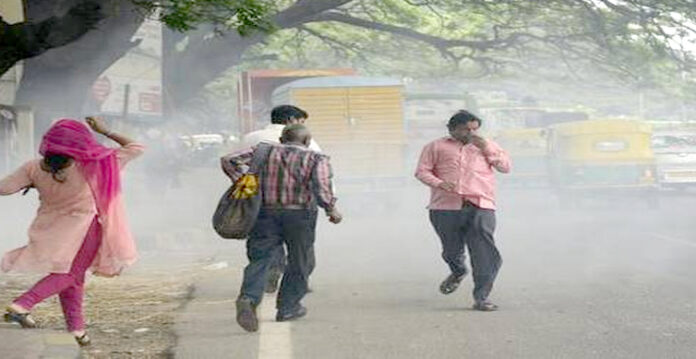As winter settles in across Hyderabad, the city is grappling with a growing environmental concern: worsening air quality. The crisp, cool mornings that many residents have come to enjoy are now accompanied by an unwelcome companion — smog, with pollution levels steadily rising.
While the drop in temperatures is welcomed by many, the air quality in the city is quietly deteriorating. For 18 out of the last 19 days, the city’s air quality has remained in the ‘moderate’ category, with little sign of improvement. On Tuesday, the temperature in Hyderabad dropped to 15.1 degrees Celsius, but pollution levels surged at the same time. The Central Pollution Control Board’s Air Quality Index (AQI) reported moderate air quality across the city, with Bollaram at 114, Central University at 95, and ECIL at 90. However, areas such as ICRISAT Patancheru (160), Pashamylaram (158), and Sanathnagar (175) recorded higher levels of pollution. Other locations like Kandi (100), Kokapet (76), Kompally (89), and Zoo Park (175) also showed significant pollution readings.
The AQI for Monday was recorded at 123, which still falls under the ‘moderate’ category, but it presents a mild risk to individuals with pre-existing respiratory issues, such as asthma or heart conditions. PM2.5, microscopic particulate matter that can penetrate deep into the lungs, has been identified as the primary contributor to the city’s declining air quality. These fine particles can aggravate respiratory and cardiovascular conditions, posing significant health risks.
Also Read: HYDRAA and PCB Join Forces to Safeguard Hyderabad’s Lakes from Pollution
The air quality has fluctuated between ‘satisfactory’ and ‘moderate’ this month. On November 14, the AQI was recorded at 93, which is relatively good, but since then, the situation has worsened steadily. On November 15, the AQI rose to 101, and by November 19, it had climbed above 110, with the pollution trend continuing to rise.
The persistent presence of PM2.5 is a major concern. These tiny particles, which can infiltrate the respiratory system, have been identified as the primary pollutant affecting the city’s air. Health experts warn that long-term exposure to high levels of PM2.5 can lead to chronic respiratory and heart diseases.
According to the AQI categories, an index value between 101 and 200 is considered ‘moderate,’ with potential breathing discomfort for sensitive individuals, including those with asthma, bronchitis, and heart disease. Unfortunately, the AQI in Hyderabad has remained in this range for over two weeks, with no immediate relief in sight.
As the winter season progresses, temperatures in the city have dipped, with certain areas like BHEL and Macha Bollaram experiencing even lower readings, hovering around 12 degrees Celsius. This has made the air even thicker and potentially more harmful. Health advisories suggest that when the AQI exceeds 150, individuals with heart or lung diseases should limit their outdoor activities to avoid exposure to the toxic air.
The weather forecast for the coming week predicts partly cloudy skies with haze. Temperatures are expected to range between a minimum of 15 degrees Celsius and a maximum of 30 degrees Celsius, continuing the trend of cooler weather but with persistent air quality concerns.
As the city endures these fluctuating pollution levels, residents and authorities alike are urged to take precautionary measures to safeguard their health, particularly those with respiratory or cardiovascular conditions.
(This story is sourced from a third-party syndicated feed. Raavi Media takes no responsibility or liability of any nature. Raavi Media management/ythisnews.com can alter or delete the content without notice for any reason.)


